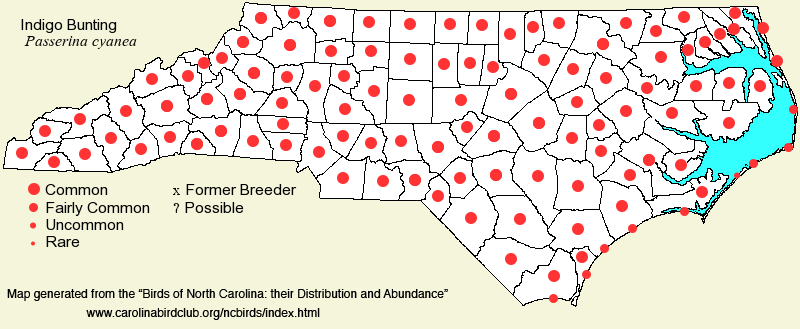 |  |
|
Indigo Bunting - Passerina cyanea CARDINALIDAE Members: | Search Common: Search Scientific: |
|
|
|||||||
| General Comments | The Indigo Bunting is one of the most successful of Eastern songbirds. It has been expanding its breeding range westward, into the range of the Lazuli Bunting, where some interbreeding has occurred. It is also one of the most abundant breeding birds in the East, including North Carolina, thanks to quickly adapting to wooded borders and ecotones. And, each winter there are one or two sightings of stragglers, though the species essentially winters in the tropics. Indigo Buntings nest primarily along forest borders, overgrown fields, and other brushy places; in fall, flocks can often be seen in weedy fields with sparrows. It is probably the most persistent singer of all of our songbirds during the heat of a summer day, even in Jul into Aug. | ||||||
| Breeding Status | Breeder | ||||||
| NC BRC List | Definitive | ||||||
| State Status | |||||||
| U.S. Status | |||||||
| State Rank | S5B | ||||||
| Global Rank | G5 | ||||||
| Coastal Plain | Summer resident, and scarce straggler into winter. In summer, very common across the province, except mostly uncommon on barrier islands. In winter, about 15 records, all but two near the coast. Mainly mid-Apr to early Nov. Peak counts: | ||||||
| Piedmont | Summer resident, and scarce straggler into winter. Very common in summer, throughout the region. Mainly mid-Apr to mid- or late Oct. About 9 winter records (3 from the winter of 2015-16). Peak counts: | ||||||
| Mountains | Summer resident. In summer, very common throughout, up to about 4,500 feet, and uncommonly to 5,500 feet; a few even to the highest elevations, where recently established. No winter records. Mainly late Apr to mid-Oct. Peak counts: | ||||||
| Finding Tips |
None needed. **** | ||||||
| Attribution | LeGrand[2023-04-12], LeGrand[2019-06-26], LeGrand[2016-09-29] | ||||||
| NC Map Map depicts all counties with a report (transient or resident) for the species. | Click on county for list of all known species. |
| NC Breeding Season Map Map depicts assumed breeding season abundance for the species. |  |